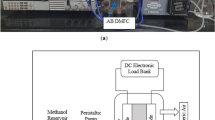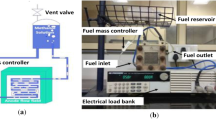Abstract
This paper investigated environmental effects of passive, air-breathing, and vapor-feeding direct methanol fuel cells (PAVDMFCs). In these experiments, main experimental parameters are temperature (30 °C, 40 °C) and relative humidity (25%, 75%). From these experimental results, the humidity plays a key role in terms of the water management at the cathode catalyst layer. During pure methanol feeding, the peak performance shows in relative humidity 25% and 40 °C. Under high humidity condition (relative humidity 75%), the water flooding of cathode blocks the oxygen reduction reaction at the cathode. The low humidity (relative humidity 25%) decreases the flooding of the cathode, in which the Warburg of relative humidity 25% decreases rather than that of relative humidity 75%. We concluded that rich water contents of the cathode slightly decrease activation overpotentials.
Similar content being viewed by others
References
Aricò, A. S., Bruce, P., Scrosati, B., Tarascon, J., and van Schalkwijk, W., “Nanostructured materials for advanced energy conversion and storage devices,” Nat. Mat., Vol. 4, No. 5, pp. 366–377, 2005.
Steele, B. and Heinzel, A., “Materials for fuel-cell technologies,” Nature, Vol. 414, No. 6861, pp. 345–352, 2001.
Guo, Y.-G., Hu, J.-S., and Wan, L.-J., “Nanostructured Materials for Electrochemical Energy Conversion and Storage Devices,” Adv. Mater., Vol. 20, No. 15, pp. 2878–2887, 2008.
Chan, Y. H., Zhao, T. S., Chen, R., and Xu, C., “A small monopolar direct methanol fuel cell stack with passive operation,” J. Power Sources, Vol. 178, No. 2, pp. 118–124, 2008.
Rashidi, R., Dincer, I., Naterer, G. F., and Berg, P., “Performance evaluation of direct methanol fuel cells for portable applications,” J. Power Sources, Vol. 187, No. 2, pp. 509–516, 2009.
Shaffer, C. E. and Wang, C. Y., “High concentration methanol fuel cells: Design and theory,” J. Power Sources, Vol. 195, No. 13, pp. 4185–4195, 2010.
Lu, G. Q., Lim, P. C., Liu, F. Q., and Wang, C. Y., “You have full text access to this contentOn mass transport in an airbreathing DMFC stack,” Int. J. Energ. Res., Vol. 29, No. 12, pp. 1041–1050, 2005.
Shimizu, T., Momma, T., Mohamedi, M., Osaka, T., and Sarangapani, S., “Design and fabrication of pumpless small direct methanol fuel cells for portable applications,” J. Power Sources, Vol. 137, No. 2, pp. 277–283, 2004.
Guo, Z. and Cao, Y., “A passive fuel delivery system for portable direct methanol fuel cells,” J. Power Sources, Vol. 132, No. 1, pp. 86–91, 2004.
Eccarius, S., Krause, F., Beard, K., and Agert, C., “Passively operated vapor-fed direct methanol fuel cells for portable applications,” J. Power Sources, Vol. 182, No. 2, pp. 565–579, 2008.
Chang, I., Ha, S., Kim, J., Lee, J. Y., and Cha, S. W., “Performance evaluation of passive direct methanol fuel cell with methanol vapour supplied through a flow channel,” J. Power Sources, Vol. 184, No. 1, pp. 9–15, 2008.
Liu, J. G., Zhao, T. S., Chen, R., and Wong, C. W., “The effect of methanol concentration on the performance of a passive DMFC,” Electrochem. Commun., Vol. 7, No. 3, pp. 288–294, 2005.
O’Hayre, R., Fabian, T., Litster, S., Prinz, F. B., and Santiago, J. G., “Engineering model of a passive planar air breathing fuel cell cathode,” J. Power Sources, Vol. 167, No. 1, pp. 118–129, 2007.
Babcock, B., Tupper, A. J., Clark, D., Fabian, T., and O’Hayre, R., “Optimization of Passive Air Breathing Fuel Cell Cathodes,” J. Fuel Cell Sci. Technol., Vol. 7, No. 2, pp. 021017-1–021027-11, 2010.
Jeong, S. U., Cho, E. A., Kim, H.-J., Lim, T. H., Oh, I.-H., and Kim, S. H., “Effects of cathode open area and relative humidity on the performance of air-breathing polymer electrolyte membrane fuel cells,” J. Power Sources, Vol. 158, No. 1, pp. 348–353, 2006.
Fabian, T., Posner, J. D., O’hayre, R., Cha, S.-W., Eaton, J. K., Prinz, F. B., and Santiago, J. G., “The role of ambient conditions on the performance of a planar, air-breathing hydrogen PEM fuel cell,” J. Power Sources, Vol. 161, No. 1, pp. 168–182, 2006.
Poornesh, K. K., Lee, S.-K., Cho, C., and Choi, K.-W., “Effect of Bipolar Plate Materials on the Stress Distribution and Interfacial Contact Resistance in PEM Fuel Cell,” Int. J. Precis. Eng. Manuf., Vol. 11, No. 4, pp. 583–588, 2010.
Author information
Authors and Affiliations
Corresponding author
Rights and permissions
About this article
Cite this article
Chang, I., Lee, M. & Cha, S.W. Characteristic behaviors on air-breathing direct methanol fuel cells. Int. J. Precis. Eng. Manuf. 13, 1141–1144 (2012). https://doi.org/10.1007/s12541-012-0151-y
Received:
Accepted:
Published:
Issue Date:
DOI: https://doi.org/10.1007/s12541-012-0151-y




